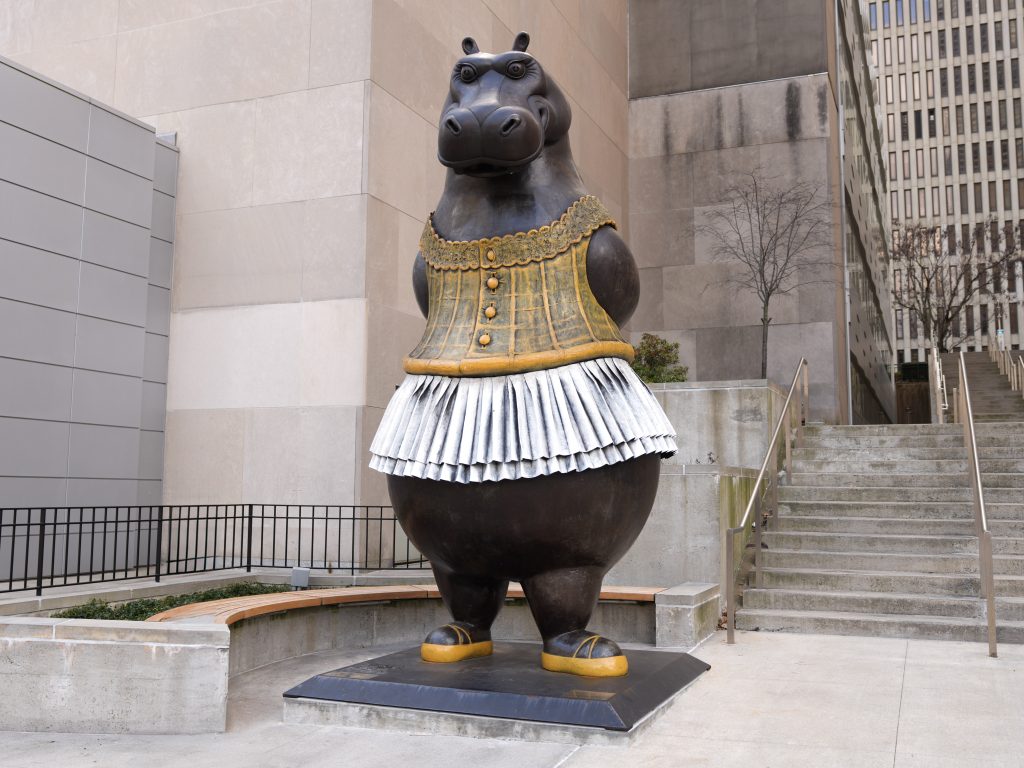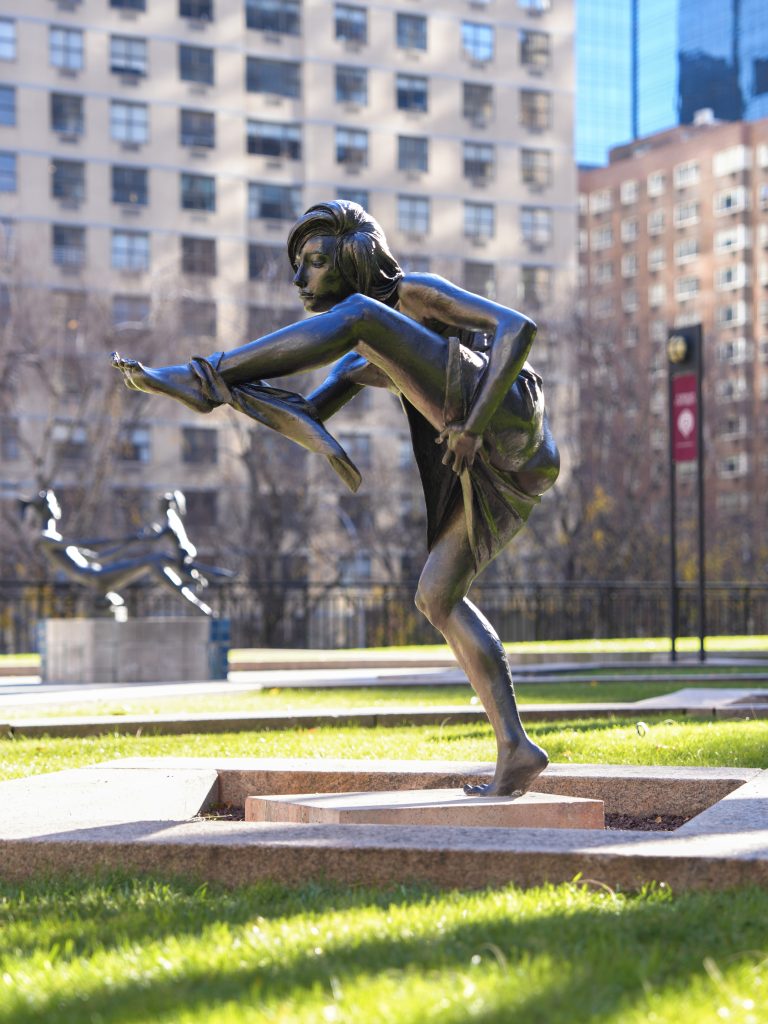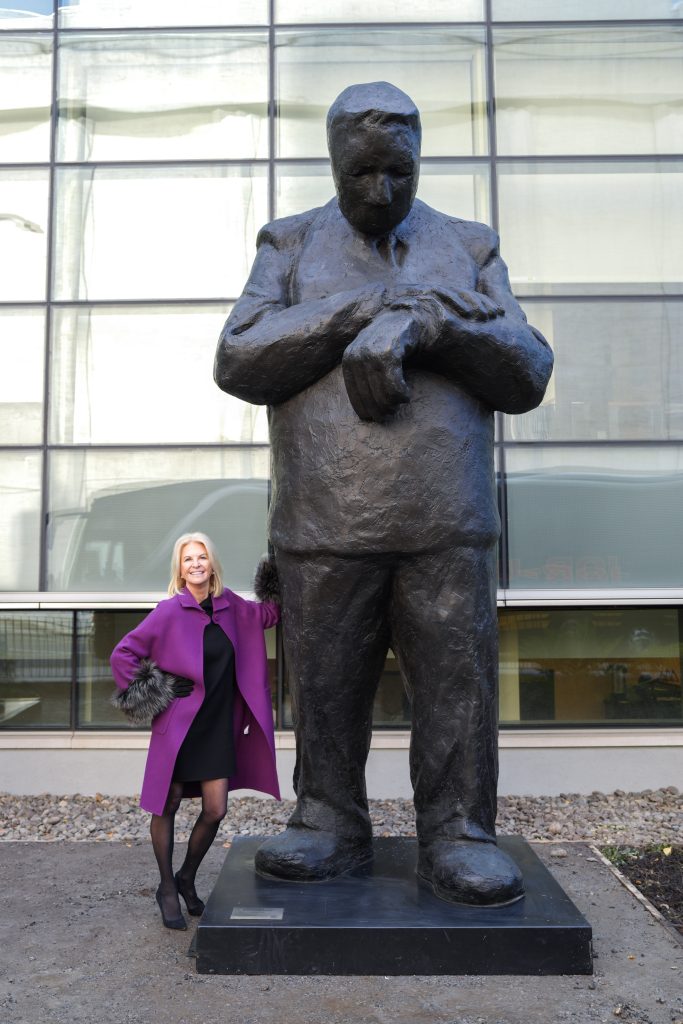The new exhibition is called “The Magis Sculpture Exhibition,” and it’s made possible thanks to the generosity of Fordham Trustee Kim Bepler in collaboration with Cavalier Galleries. In total, Fordham received 11 new pieces of sculpture on loan from the gallery, which has a location in Nantucket where Bepler has a home. While chatting with gallery owner Ron Cavalier one day, she learned that he was about to de-install an exhibition in Stamford, Connecticut, and that all of the sculptures would be put into storage temporarily.
“I asked if he would be willing to bring them to our Lincoln Center campus instead, and that’s how we got started,” Bepler said.
Fordham’s Sculpture Walk
As part of the exhibition, Fordham received three large-scale sculptures that were installed along 62nd Street: two towering male figures by Jim Rennert, called “Inner Dialogue” and “Timing,” both over 12 feet tall, as well as a 15-foot Bjørn Skaarup sculpture called “Hippo Ballerina,” an iconic two-ton hippopotamus wearing a tutu that visitors may recognize from her various appearances around town.
The eight additional new pieces are featured on the campus’ plaza—one flight above street level and open to the public. These include four bronze female figures by American artist Jane DeDecker and Italian artist Bruno Luchessi; and four more whimsical creatures sculpted by Skaarup, a Danish artist.
These new pieces join the ten existing sculptures on Lincoln Center’s campus, which include several pieces that highlight Fordham’s identity: A ram on the upper plaza, a nod to Fordham’s mascot that was sculpted by Harry M. Stierwalt, Jr.; the statue of St. Ignatius, which stands outside the steps to the upper level along Columbus Avenue, sculpted by Chris Vilardi; and the statue of St. Peter called “Peter the Fisherman,” on the plaza near the entrance to McKeon Hall, sculpted by Frederick Shrady.
To showcase all of the sculptures, Fordham is creating a walking tour called “Fordham’s Sculpture Walk.” Students and members of the public are invited to participate in the free walking tour, scan the QR codes on each sculpture, and learn more about these works of art.
Educating the Whole Person
Together with her late husband, Steve Bepler, FCRH ’64, a longtime Fordham supporter and trustee, Kim Bepler has been a dedicated and generous donor to Fordham for many years. Her prior philanthropic efforts have focused on enhancing Fordham’s STEM programs—the University established five science chairs with major gifts from her and Steve’s estate—in addition to campus beautification efforts, Fordham’s sailing program, a fund for Ukrainian students, and more.
Bringing these sculptures to campus reflects her commitment to the arts as part of a well-rounded Jesuit education.
“My motivation comes from my love for my late husband and his love for his Fordham education,” Bepler said.
“Jesuit education is the education of the whole person—the soul, the inspiration, the arts … I hope these sculptures will be inspiring, and that they’ll give people a moment to pause and reflect as they wander through campus, studying and enjoying our outdoor space.”
]]>Kim Bepler, a Fordham trustee fellow, is providing a dollar-for-dollar match for all donations to the new Fordham Ukraine Crisis Student Support Fund, up to $50,000. The fund will be used for essential needs such as meals, housing, emergency health care, travel funding, tuition assistance, and more.
It is meant to help roughly a dozen Fordham students from the two countries whose finances, and lives, may have been disrupted because of the conflict. A few of those students have already sought help from the University, and more are expected to do so.
Bepler said she offered the funding as a way to help Fordham students who have lost not only their funding sources but also their sense of certainty and stability.
“I feel strongly about the situation, especially [because of]the students and how vulnerable they must feel when they have no access to their family and they don’t know what’s going to happen to them next,” she said. “It’s not fair.”
The war has caused anguish and a sense of helplessness for some Fordham students who have family members in Ukraine who are caught up in the conflict. It has prompted rallies and discussions in the University community, as well as a fellowship program cosponsored by Fordham’s Center for Jewish Studies to help Ukrainian scholars carry on with their work, despite the conflict.
The Russian invasion has caused $565 billion in economic losses in Ukraine, one of its government ministers said on March 28, and more than 4 million refugees have fled Ukraine since the start of the invasion, according to the United Nations High Commissioner for Refugees.
Russian students are vulnerable too, as financial freezes in response to the Russian invasion can keep Russian families from supporting their students in the U.S. These young people may also be impacted emotionally by the backlash that Russians around the world are facing due to Putin’s actions. Bepler expressed hope that Russian students would not feel burdened or isolated by an action begun by the Russian president.
“This is symbolic of defending democracy against a madman,” she said. “In response to the madman, we’re going with magis,” she said, referring to the Jesuit concept of always seeking more opportunities to help others.
“If my small gesture helps one student do one simple thing much easier, and with less pain,” she said, “I feel very blessed.”
Donate to the Fordham Ukraine Crisis Student Support Fund.
To apply for assistance from this fund, please contact Brian Ghanoo, assistant vice president, Office of Student Financial Services, at 718-817-3811 or [email protected].
]]>

